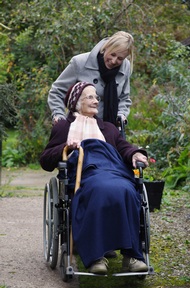End of life care improves with more dying in care homes than hospital
Around 24,000 more people died at home or in care homes in 2012 compared to four years ago, showing a rise in the number of people who are dying in a place of their choice.

The proportion of people dying at home or in care homes increased from 38 per cent in 2008 to 44 per cent in 2012, according to a new report on end of life care.
The report ‘What We Know Now’ from Public Health England’s National End of Life Care Intelligence Network (NEoLCIN) also found there were large variations in the proportion of deaths in hospital between 2009 to 2011.
Local authorities with highest and lowest rates ranged from 69 per cent in some areas to 38 per cent in others, although the reasons for this are complex, according to Public Health England.
Home is the preferred place of care and death for the majority of people, according to research carried out over the last few years by both the think tank Demos and the National Audit Office.
Professor Julia Verne, clinical lead at Public Health England’s (PHE’s) National End of Life Care Intelligence Network said: “This is the second annual report summarising research across the country on where people die and what influences this.
“This year has seen another leap forward in our understanding and the statistics reflect progress by the NHS and the voluntary sector in supporting more patients to die in their place of choice. However, we cannot be complacent, the report highlights some aspects of patient experience which must improve, especially the care of the dying in hospital.”
Professor John Newton, chief knowledge officer at Public Health England said: “Three years ago we knew very little about how and where people died in England. The National End of Life Care Intelligence Network has made a huge difference and the new knowledge is being put rapidly into action to enable people to have a better death.”
Eve Richardson, chief executive of the National Council for Palliative Care and the Dying Matters Coalition called the improvements in end of life care “very welcome” but added: “There remain some very real challenges, especially in ensuring that all people, whoever they are, whatever their needs and wherever they live, are able to get the end of life care that is right for them.”
The National End of Life Care Intelligence Network (NEoLCIN) has, in just three years, established itself as a leading national and international source of information on where, how and why people die in England, and the services provided to support them.
Statistics from Public Health England reveal that 36.2 per cent of deaths in England are in the 85 and over age group. Approximately 50 per cent of all female deaths occur in women aged 85 and over, and 30 per cent of all male deaths.
The South of England has the highest percentage of 65s and over in England. London has the lowest. In Devon, Cornwall and Somerset, one in five people are 65 or over compared to almost one in nine in London. The proportion of people aged 65 or over ranges from seven per cent in Tower Hamlets to 25.1 per cent in Dorset. Urban areas have lower percentages of older people.
The report ‘What We Know Now’ can be found at www.endoflifecare-intelligence.org.uk/resources/publications/what_we_know_now_2013
Latest News
 29-Jul-24
Dementia Bus gives carehome.co.uk staff insight into life with dementia
29-Jul-24
Dementia Bus gives carehome.co.uk staff insight into life with dementia
 01-Mar-24
Find out the top care homes in 2024
01-Mar-24
Find out the top care homes in 2024
 21-Mar-23
UK's top care homes in 2023 revealed
21-Mar-23
UK's top care homes in 2023 revealed
 03-Jan-23
carehome.co.uk launches free care helpline
03-Jan-23
carehome.co.uk launches free care helpline
 13-Dec-22
5 mins with Emily Whitehurst, chief operating officer for Constantia Healthcare
13-Dec-22
5 mins with Emily Whitehurst, chief operating officer for Constantia Healthcare